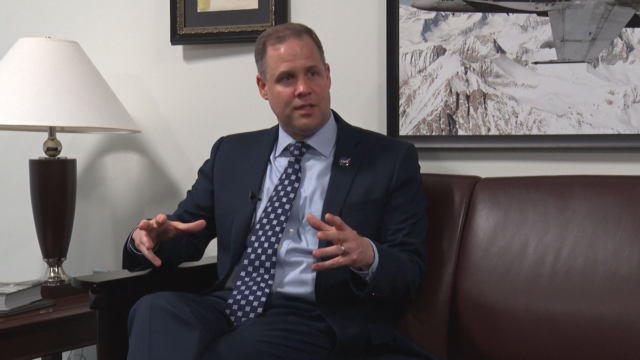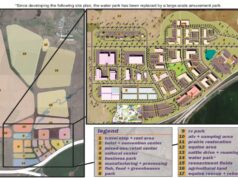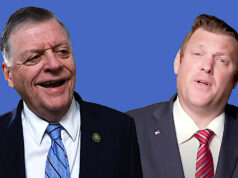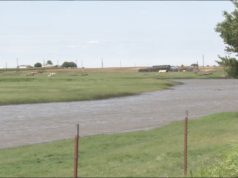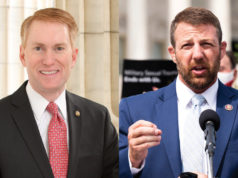(Editor’s note: The following story appears courtesy of Gaylord News, a reporting project of the Gaylord College of Journalism and Mass Communication.)
Every inch of wall in Jim Bridenstine’s childhood bedroom was covered.
Not a blank spot peeked through the pictures of airplanes that he collected from magazines or bought from Kmart and plastered around his room growing up in the ‘80s.
Framed photos of the planes he flew as a Navy fighter pilot — reminders of a boyhood dream now realized — still hovered over his shoulder when he sat last week on the couch in his spacious office.
But Bridenstine, appointed head of NASA one year ago Tuesday, now has his mind set on a vision for humanity that surpasses earthly aspiration.
He ticked off short-term goals on each finger: Launch American astronauts from American soil on American rockets this year. Go to the moon by 2024. Stay on the moon and utilize its resources.
Long term? Go to Mars.
Bridenstine now faces the biggest challenge of any NASA administrator since James Webb, who led the agency during the preparation for its first lunar mission in the 1960s.
Webb, who led the space agency during the Kennedy and Johnson administrations, like Bridenstine, was a pilot and then served in the political sphere serving in various roles in the executive branch.
“It could be argued that NASA would not have achieved the moon landing in 1969 if it wasn’t for (Webb’s) understanding of how to get the means to achieve the ends,” Bridenstine said.
That’s what he sees as his role now — getting the means to achieve the ends.
Also like Webb, Bridenstine just might be serving the most enthusiastic president and vice president when it comes to going to the moon since Kennedy and Johnson, said Rep. Frank Lucas (R-OK).
Critics’ doubt of the feasibility of this mission is perhaps surpassed only by Bridenstine’s boyish optimism. He repeats, “We’re going to …” like a mantra. There is no “try.”
“That’s the vision that the president put in Space Policy Directive one,” Bridenstine said. “And that’s my charge to carry out.”
The short-term goals Bridenstine and NASA have planned may still be hard to accomplish. On Saturday, an explosion occurred during a test of the SpaceX Crew Dragon capsule’s engine, which could impact the plans to launch American astronauts on American rockets from American soil.
Transition from Congress to NASA
Drop words like “electromagnetic spectrum” or “frequency hopping for anti-jam capabilities” to the lawyers who walk the halls of Congress, and you get a lot of blank looks.
“But as a Navy pilot, that was right in my wheelhouse,” Bridenstine said. “I could go in and talk about issues that were relevant to the space industry and lead on those initiatives. So that’s what I did.”
His interest in NASA and space didn’t begin when President Donald Trump nominated him to head the agency, Lucas said.
“Go back and pull the C-Span clips of the science committee hearings in his almost six years in the United States House,” Lucas said. “You will see that from day one he was enthusiastic — fired up about the mission of NASA and all the various elements within that.”
Bridenstine, who represented Oklahoma’s 1st Congressional District from 2013 to 2018, was entrenched in space long before he took the helm at NASA. He served on the House Armed Services Committee and the House Committee on Science, Space and Technology during his three terms in Congress, chairing the subcommittee on environment and sitting on the space subcommittee.
These roles positioned Bridenstine to be a key player in developing space policy. From where he sat in Congress, he sometimes found himself frustrated by the agency going over budget or not meeting deadlines. Now, he gets it.
“When you have to invent brand new technologies at the very leading edge of science, it’s not as easy as you might presume,” Bridenstine said.
Despite his space-focused agenda as a lawmaker, many Democrats, and even Republicans, were not happy when President Trump nominated Bridenstine, a Republican, to fill the role in 2017 as the leader of NASA, a traditionally bipartisan, apolitical agency.
Oklahoma connection
Oklahomans aren’t strangers to space.
Oklahoma companies have manufactured parts for space programs from the Mercury program in the early 1960s through the space shuttle, said Victor Bird, director of the Oklahoma Aeronautics Commission.
“We’ve had a very rich history and heritage in space exploration here in Oklahoma,” Bird said.
Manufacturing aside, Bridenstine said he sees other areas where Oklahomans can play a part in the work NASA is doing. He pointed to a government contract the University of Oklahoma won to measure carbon emissions looking from geostationary orbit.
“I want to do what I can to make sure that Oklahoma is aware of what their capabilities are so they can bid on more projects and help us out even more — help this agency out,” Bridenstine said.
The Sooner State also has more astronauts per capita of any other state in the nation, according to Bird. This includes Owen Garriott, an Enid native who traveled to space twice, who died last week.
“Folks like that are an inspiration, not just to me, but to people all over the country and all over the world,” Bridenstine said.
Though he did not know Garriott personally, Bridenstine said Oklahoma has had great leaders in the space field who he has had experiences with that have inspired and encouraged him to get more involved in space.
Another astronaut from Oklahoma, Lt. Gen. Thomas Stafford, said Bridenstine is doing a good job in a tough situation.
“Now big challenge, big big big challenge … the vice president announced … that we want to have boots back on the moon by 2024,” Stafford said. “That’s going to be one hell of a job.”
Stafford also pointed to Webb as someone who, like Bridenstine, wasn’t a technical man but knew Washington, and he said Bridenstine should rely on his staff to help him.
With the challenges of going to the moon and beyond in front of him at the end of his first year at NASA, Bridenstine seems excited about what will happen in his years to come with the agency.
“I’m completely humbled by my opportunity to be here at NASA,” Bridenstine said. “It only happened because the people of Oklahoma trusted me to represent them to the best that I could, and I did it for five and a half years to the absolute best of my ability. I loved every minute of it, and I hope that I can serve them well here as the NASA administrator.”








